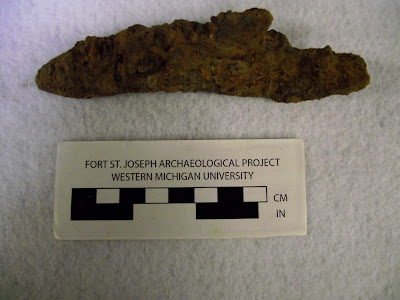Hello readers, this is
Connor again with an update on my excavation unit. So far this week we’ve had
some pretty amazing artifacts that showed up in the pit. Our unit is primarily
a bone midden (or bone pile) but these artifacts aren’t quite what one would
expect to find thrown out with the food scraps.
When we had reopened the excavated unit from last year
that we are currently working with, we noticed an unnaturally shaped piece of
stone in the bottom of the unit. We had a feeling that it was going to turn out
to be French gun flints, but we couldn’t do anything about it until we got our
unit cleaned up, photographed, and mapped. This week though, we were finally
able to excavate the unit and came across not just one French gun flint, but
three of them in just two days. These pieces of stone can be easily identified
by their distinct honeycomb color and were used to ignite the gunpowder in
muzzle loading weapons (flint lock guns). More interesting was the various
degrees of which these flints had been used, as indicated by their patterns of
wear. The first was about the size of a quarter and showed a good bit of usage
while the second one we recovered was quite small from being repeatedly struck.
The last one, however is stuck within the wall and there is no way of telling
how big it is.
The second, but maybe more fascinating of the two, we
found lying on top of a flat rock in the bottom of the unit. It is just over 5
inches long and made entirely out of iron. We didn’t know precisely what we
were looking at when it was recovered, but we figured that it was probably gun
part based on the size. We really wanted to know more about the piece so we
took it back to the lab, cleaned it up and opened up the reference books. Since
we had hypothesized that the artifact was a gun part we looked immediately at examples
of previously found gun parts in Michigan. It didn’t take long to figure out
that it was a gun lock. This was the part of the flint lock firing mechanism
that was on the side of the gun. It is the piece of metal that holds the entire
flint lock mechanism together and fastens it to the wood of the gun.  |
| The iron lock recovered in our unit. (Photo Credit: Austin George) |
Finally we
uncovered a couple bizarre items that have never been found on the Fort St.
Joseph site before. These three items are between 1 ½ to 2 ½ inches long and
appear to be made out of a copper alloy. They are coiled and resemble modern
day springs but seem to be much too thin to have come from a gun. With that
information we are left scratching our heads as to what these springs could
have come from, though we do have some ideas. One hypothesis to their origin is
that they were part of a clock, which could hold true as clocks were a popular
piece of décor during the 18th century. But then again it is just a
theory and we would like to know what you think of these might be!
 |
| The mysterious springs.. What could they be? (Photo Credit: Austin George) |
2 comments:
The springs could be hair plucking springs traded to the natives. The spring would be threaded on a stick the coils pulled apart and placed over a hairy spot and then relaxed and pulled back to remove the hair.
Thomas Wojcinski
Another idea posed by some colleagues is they are for decoration about the ear lobe. As natives might sever the cartilage there and adorn it.
Tom wojcinski
Post a Comment